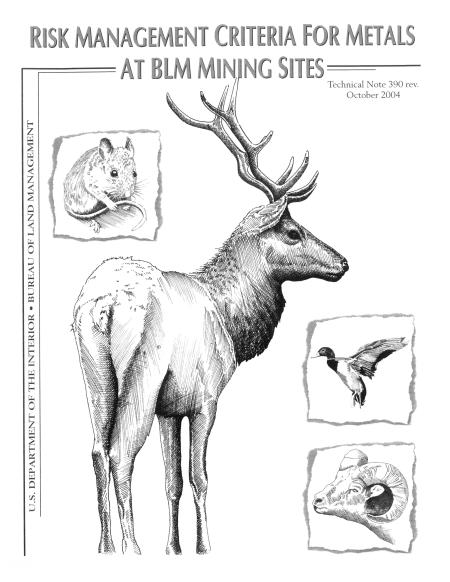Risk Management Criteria for Metals at BLM Mining Sites

Mining activities have influenced the environment of Public Lands throughout the West. Tailings from ore mills have contributed large amounts of heavy metals into air, water, stream sediments, and soils. Uncontrolled migration of metal-laden mine tailings via dust entrainment and erosion continues to present potentially adverse risks to human health and wildlife. Recreational demands are increasing on areas where acute and prolonged exposure to relatively high metal concentrations in soils, sediments, and surface waters is occurring. In some locations, avian and aquatic kills have been reported.
To address these issues, BLM has developed acceptable multimedia criteria for the chemicals of concern (heavy metals) as they relate to recreational use and wildlife habitat on BLM lands. The primary objective of this report is to establish risk management criteria (RMC) for human health and wildlife. Risk management criteria provide numerical action levels for metals in environmental media. RMC are designed (1) to assist land managers in making natural resource decisions and (2) to support ecosystem management. Ecosystem management is defined as the skillful use of ecological, economic, social, and managerial principles in managing ecosystems to produce, restore, or sustain ecosystem integrity and desired conditions, uses, products, or values and services over the long term.
RMC designed to protect human receptors for the metals of concern were developed using available toxicity data and standard U.S. Environmental Protection Agency (EPA) exposure assumptions. RMC designed to protect wildlife receptors for the metals of concern were developed using toxicity values and wildlife intake assumptions reported in the current ecotoxicology literature. Ingestion of soil, sediment, and plants is assumed to be the predominant source of metal exposure for wildlife receptors.
The contaminants of concern and metal contamination migration pathways were identified from historical information and site visits. Potential receptors, receptor exposure routes, and exposure scenarios were identified from on-site visits and discussions with BLM personnel. Representative wildlife receptors at risk were chosen using a number of criteria, including likelihood of inhabitation and availability of data. Risk management criteria should be used by the land manager as a cautionary signal that potential health hazards are present and that natural resource management or remedial actions are indicated. Furthermore, these criteria may be used as target cleanup levels if remedial action is undertaken.
